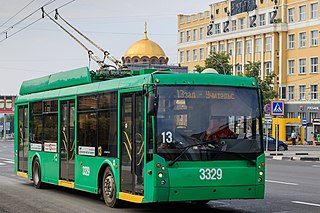
A trolleybus is an electric bus that draws power from dual overhead wires using spring-loaded trolley poles. Two wires, and two trolley poles, are required to complete the electrical circuit. This differs from a tram or streetcar, which normally uses the track as the return path, needing only one wire and one pole. They are also distinct from other kinds of electric buses, which usually rely on batteries. Power is most commonly supplied as 600-volt direct current, but there are exceptions.
AZLK is a Soviet and Russian automobile manufacturer (Moscow), the maker of the Moskvitch brand.

OJSC AMO ZiL, known fully as the Public Joint-Stock Company – Likhachov Plant and more commonly called ZiL, was a major Russian automobile, truck, military vehicle, and heavy equipment manufacturer that was based in Moscow.

The Malyshev Factory, formerly the Kharkov Locomotive Factory, is a state-owned manufacturer of heavy equipment in Kharkiv, Ukraine. It was named after the Soviet politician Vyacheslav Malyshev. The factory is part of the state concern, Ukroboronprom.

MTV-82 is a Soviet four-axle tramcar.

The ZiU-5 is a Soviet trolleybus model that was built by the Uritsky factory. The ZiU acronym stands for Zavod imeni Uritskogo, which translates as Plant named after Uritskiy. This model of city trolleybus was in mass production from 1959 to 1972. The total number of ZiU-5s produced exceeded 14,500 vehicles. This allowed the ZiU-5 to become dominant model of trolleybus in Soviet towns and cities of that time. The last vehicles were withdrawn from active service in the mid-1980s. The small number of surviving vehicles are kept now for museum purposes.

ZiU-9, or ZIU-9 is a Soviet trolleybus. Other names for the ZiU-9 are ZiU-682 and HTI-682. The ZiU acronym stands for Zavod imeni Uritskogo, which is a factory named after Moisei Uritsky, the Russian revolutionary. Before 1996 this acronym was also a trademark of the vehicle manufacturer Trolza. The ZiU-9 was first built in 1966, although it was only put into mass production in 1972 and it was still assembled along with other more advanced trolleybus vehicles in the Trolza factory until 2015. The total number of produced ZiU-9s exceeds 42,000 vehicles making it the most produced trolleybus in the world. In addition, many copies of ZiU-9 were made in other factories of the former Soviet bloc.

A Warsaw trolleybus system formed part of the public transport network of Warsaw, the capital city of Poland, during two separate periods. The first trolleybus system was established in 1946 and lasted until 1973. It had a maximum of 10 routes. The second system, comprising only one route, was in operation from 1983 until 1995. Between 1992 and its closure, it was operated by Zarząd Transportu Miejskiego (ZTM), in English the Public Transport Authority (Warsaw).

ZiU-10 or ZIU-10, also referred to as ZIU-683, is a model of trolleybus, built in Russia. It was manufactured from 1986 until 2008 by the Uritsky Factory, in Engels, which later became Trolza. It is an articulated, three-axle variant of the ZiU-9/ZiU-682. A modified version of the ZiU-10 is the ZiU-6205.

The first trolleybus vehicle in Russia was built in Saint Petersburg in 1902 at Frese machine-building factory. It utilised a carriage-type current collector like the early von Siemens prototypes. There was no attempt to organize passenger or cargo services at this time.

The Dushanbe trolleybus system forms part of the public transport network of Dushanbe, the capital and largest city of Tajikistan. In operation since 1955. The system presently comprises eight routes as of 2006.

The Córdoba trolleybus system is part of the public transport network in Córdoba, the capital city of Córdoba Province, Argentina.

The Rosario trolleybus system is part of the public transport network in Rosario, the largest city in the province of Santa Fe, Argentina.
The Sumqayit trolleybus system was a system of trolleybuses forming part of the public transport service in Sumqayit, the third most populous city in Azerbaijan, for most of the second half of the 20th century.
The Ganja trolleybus system was a system of trolleybuses forming part of the public transport arrangements in Ganja, the second most populous city in Azerbaijan, for most of the second half of the 20th century.

The Chișinău trolleybus system forms an important part of the public transport network in Chișinău, the capital of Moldova. The system was created shortly after the end of the World War II to replace the old electric tram system that suffered extensive damage during the war. Along with the network of minibuses known as rutierele, it forms the backbone of the Chișinău transport system, with the average daily ridership reaching 250,000 passengers per day.

The production of urban electric transport is a branch of Russian engineering. Russia has the largest number of trolley (85) and tram systems (86) in the world.

The Novosibirsk trolleybus system is part of the public transport network of Novosibirsk, Russia. The system opened on 6 November 1957.

The Tashkent trolleybus system is a closed trolleybus system in Tashkent. Having existed for nearly 63 years, what was once Central Asia's largest trolleybus system was shut down on May 1, 2010.

The MTB-82 is the designation of a type of Soviet trolleybus. The rigid buses were initially developed and manufactured by the Savod No. 82 armaments plant in the Moscow suburb of Tushino. In 1951, series production was transferred to the civilian company Sawod imeni Urizkogo, which was located in the Saratov Oblast, RSFSR. This company currently operates under the name Trolza.


![Trolza-62052.01 [62052B] in Belgrade, Serbia Trolza Belgrad.jpg](http://upload.wikimedia.org/wikipedia/commons/thumb/1/16/Trolza_Belgrad.jpg/220px-Trolza_Belgrad.jpg)
















